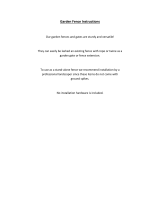Page is loading ...

www.mastergardenproducts.com
Installing Willow Rolled Fencing in the Garden
It is necessary to have a rigid structure to support most rolled fences for adequate installation. If it is
being applied to an existing wooden fence which provides a flat vertical plane surface, the rolled fence
can be held to the existing fence with galvanized wire or staples applied with a staple gun. Galvanized or
stainless staples are recommended. If the existing fence is a chain link fence and the fabric of the fence
is on the side to receive the reed, the material can be wired through the vertical fence materials to the
chain link with galvanized wire. The wiring should be done about every 4-5 inches at the top, bottom and
middle of the fence. We recommend and prefer using galvanized wire to tie the rolled fences whenever
possible. IMPORTANT NOTE: When tying or stapling, all rolled fences with a wire line should be
tied or stapled on the existing wire that are weaving them. This will blend the galvanized wire and
staples to the existing wire and firmly hold the fences' structure.
If there is no structure, it will be necessary to install posts to support the roof fences. When the existing
structure does not have at least a top and bottom rail in a vertical plain, it will be necessary to add some
construction to get that supporting structure. If the rolled fences is to be applied to a chain link fence on
the side with the rails and posts, it will be necessary to add a lower rail (unless there is one there
already). This can be another chain link steel rail or merely a 2"x2" cedar wood drilled and wired between
posts. You must have some structure at the top of the rolled fences and the bottom in a plane to press the
fence against. If the existing fence is 4' high and the fence you are installing is taller (i.e. 6') then you
need to construct a frame up to the 6' height. See the drawing below that is displaying a typical cedar
wood fence support frame.
Once the backing is in place the
rolled verticals can be applied. Roll it
out on scrap boards that are about an
inch thick laying on the ground. This
insures that the fence is straight and
leveled and that it will be supported
just above the ground while it is being
secured. The rolled verticals can be
wired temporarily with galvanized
wire in several places for
convenience. Some fences like the
reed fence and the dwarf pines can
be trimmed as needed both vertically
and horizontally. Use sharp pruning
shears. Bamboo pole fences can be
cut to your custom length by using a
pair of heavy duty scissors. All that is
required is to cut the wire at the
length you desire and twist the wire to seal the end of the cut. Trimming the height can be done with a
miter saw. First you need a miter saw with a saw blade with a minimum of 60 teeth, the type that is used

to cut aluminum or trimming boards. Make sure you run the saw until maximum speed before you do the
actual cutting to minimize splitting of the bamboo/willow.
To attach the rolled fences to the posts and stringers, secure the fencing to the end post with 10 inch
pieces of galvanized wire, and straighten and align to your satisfaction. Then use the 8 inch lengths to
attach the fencing to the stringers, and the 10 inch lengths to attach the fencing to the posts, a second
person is required as the person on the other side will adjust the fencing, bend the wire, and pass it
through to the other person. That person will use the pliers to pull and twist the ends together. When you
reach the end of one roll, wire another roll to it. When you reach the end post, wrap the rolled fence
around it and secure with wire.
/









